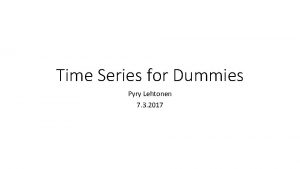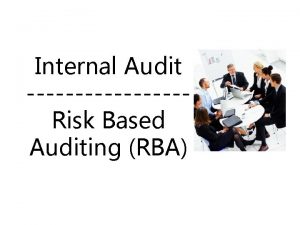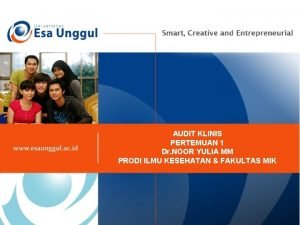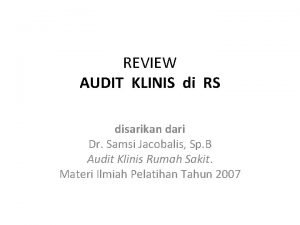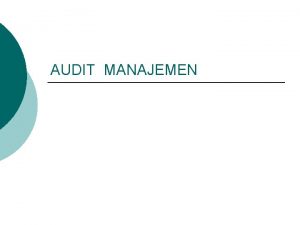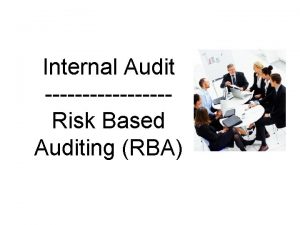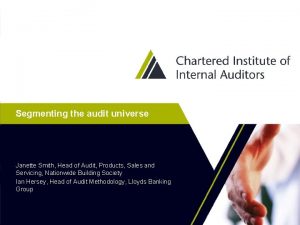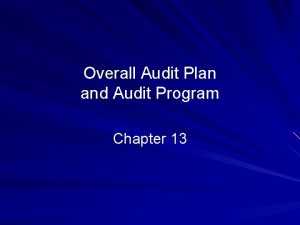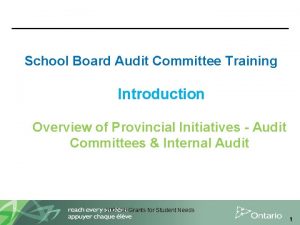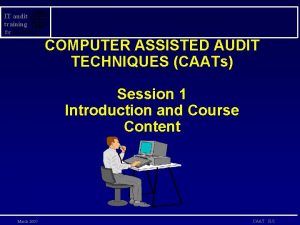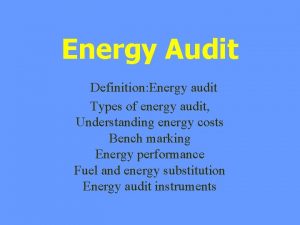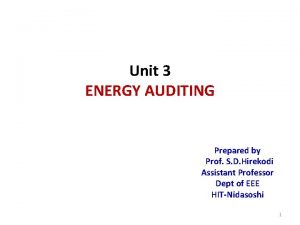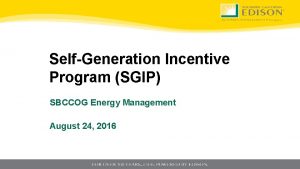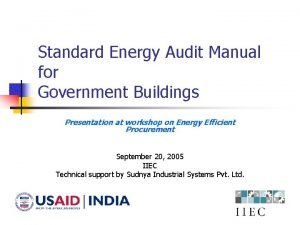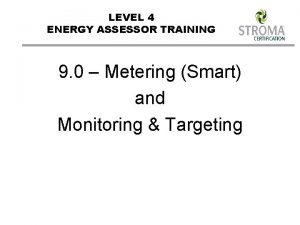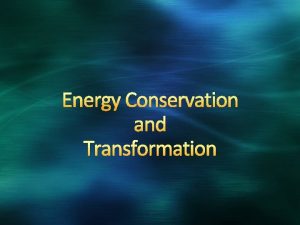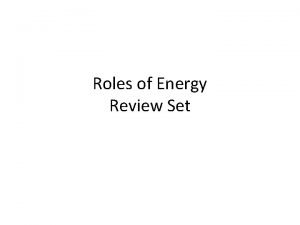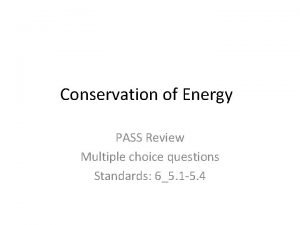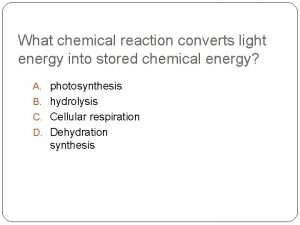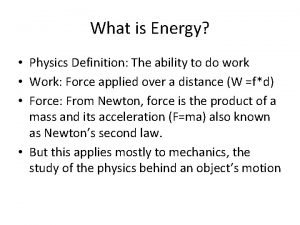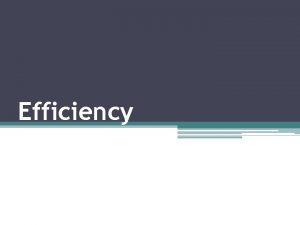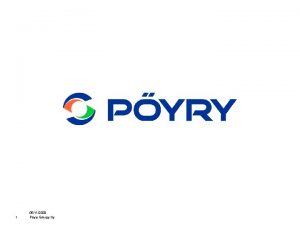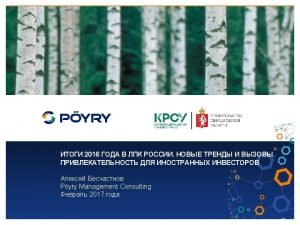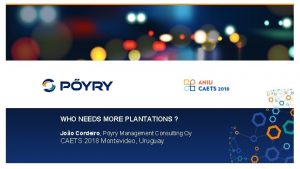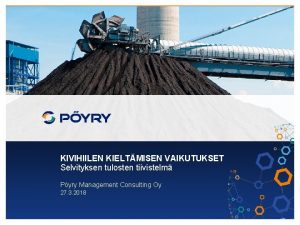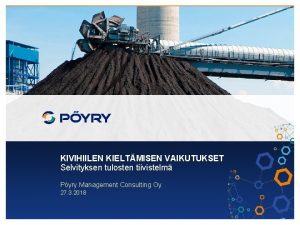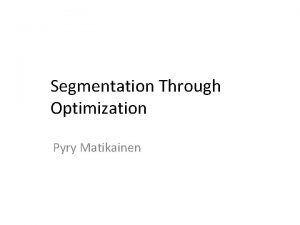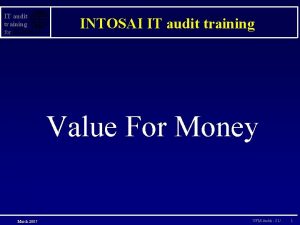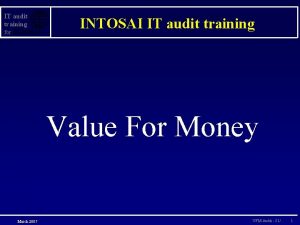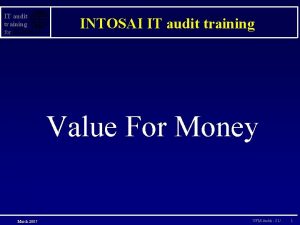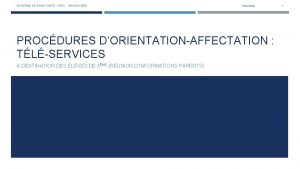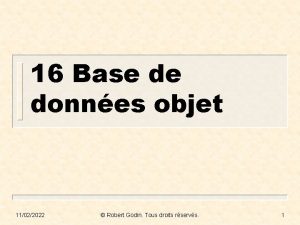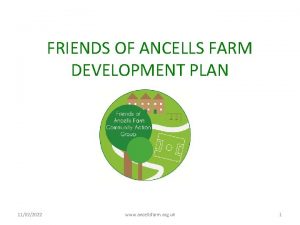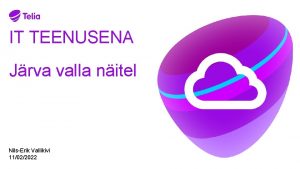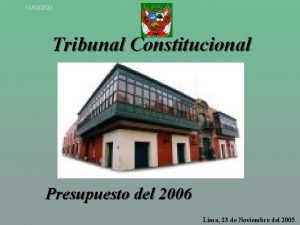1 11022022 Pyry Energy Oy Energy audit training





















































- Slides: 53

1 11/02/2022 Pöyry Energy Oy

Energy audit training in St. Petersburg Energy audit for CHP and thermal power plants in Finland November 8 th, 2007 Carlo Di Napoli Pöyry Energy Oy, Finland 2 11/02/2022 Pöyry Energy Oy

Outline A. Development of the Audit Model I. II. Historical Aspects Motiva Analysis Model B. Implementing the Model in Different Power Plants Scheduling and Project Phases II. Savings Calculations III. Auxiliary Means I. C. Results and Experiences D. Case Studies I. II. 3 CHP power plant in a Pulp and Paper Mill Municipal power plant in Northern Finland 11/02/2022 Pöyry Energy Oy

Development of the Audit Model – Historical Aspects • Energy efficiency assessment work has always played a role in power industry – Feasibility studies, energy balance calculations, condition monitoring, etc. • Energy efficiency assessment work in Finland had traditionally mainly focused on demand side • Potential for power plant performance improvement and process integration to the mill has not been fully utilised • Energy volumes at the power plants are considerable compared to the industry production plants 4 11/02/2022 Pöyry Energy Oy

Development of the Audit Model – Motiva Analysis Model • Power Plant Energy Analysis model was introduced within the Finnish Energy Efficiency Scheme in 2002. Model was designed by Pöyry Energy (former Electrowatt-Ekono Oy) • Model development was based on previously done assessment projects (ca. 10 projects, received from Motiva) • Target was to define most potential systems and most economic work method 5 11/02/2022 Pöyry Energy Oy

Development of the Audit Model – Motiva Analysis Model • Power Plant Energy Audit Model includes – brief work instructions – reporting model (with remarks) – an example report of power plant energy audit • Scope plants: Municipal and industrial power plants – CHP power plants • Conventional boiler plants (Peat, Coal, Oil, etc. ) • Combined cycle power plants with gas turbine – Condensing power plants – Nuclear, wind and hydroelectric power plants are excluded • Analysing concentrated on power plant processes • Audit includes a plan and a schedule for implementing the proposed saving • 6 measures Since its introduction, Power Plant Energy Efficiency Analysis model has been tested at several power plants and pulp and paper mills 11/02/2022 Pöyry Energy Oy

Development of the Audit Model – Motiva Analysis Model • Motiva Analysis Report Model 4. Plant processes 3. Energy Production and use 2. Basic info Kauppa- ja teollisuusministeriön tukema energiakatselmushanke DNro: 333/954/93 Päätöksen pvm 30. 12. 1993 ENERGY ANALYSES REPORT JP-TALOTEKNIIKKA Company Ltd 1. Summary - text - tables 1, 2 - economical profitability TABLE 2 Now Fuels (GWh/a) Heat prod. Efficiency (%) Investments (€) Company Oy Jaakko Pöyry Group PL 27, 00131 HELSINKI Puh. 09 - 46911 Fax. 09 - 4691 311 7 11/02/2022 Pöyry Energy Oy Savings € TABLE 1 Electr prod. Helsinki 5. 9. 1999 5. Saving measures, economy and impacts After Saving measur. 1 Saving measur. 2 : : Total Invest. € Pay back period A p p.

Development of the Audit Model – Motiva Analysis Report Model Report Main Contents 1. Basic Information – Short presentation of the plant 2. Energy Use – Total production – Total fuel consumption – Total energy delivery – Energy efficiency 3. Energy saving potential, required investments and payback periods 4. Detailed list of saving measures 8 11/02/2022 Pöyry Energy Oy

Motiva Analysis Report Model – Basic Information • General Information – Location – Ownership – Energy consumers • Power plant key figures – Production – Process diagrams & lists of main equipment – Used Fuels 9 11/02/2022 Pöyry Energy Oy

Motiva Analysis Report Model – Energy Production and Use • Energy Management System – Available data and measurements (e. g. monthly reports, hourly data, guarantee test results) • Delivered energy figures – Heat, electricity and steam loads – Limit values • Energy balances of the plant – Energy balance (Sankey diagram, annual energy balance) – Fuels (e. g. properties, flows) – Own consumption 10 11/02/2022 Pöyry Energy Oy

Motiva Analysis Report Model – Example: Energy Balance as a Sankey Diagram 11 11/02/2022 Pöyry Energy Oy

Motiva Analysis Report Model – Savings Potential – Main Equipment Data • Boilers Steam pressure and temperature, fuels, year of implementation Auxiliary equipment Measurements Guarantee and condition monitoring tests Gas turbines – Performance characteristics of compressor, turbine and generator, year of implementation, fuels – Measurements – Guarantee and condition monitoring tests Steam turbines – Reheats, bleedings, steam values – Condenser, generator – Auxiliary equipment – Measurements – Guarantee and condition monitoring tests – – • • 12 11/02/2022 Pöyry Energy Oy

Motiva Analysis Report Model – Savings Potential – Basis of Calculation • • 13 Prices – Fuels – Water (both demi and raw) – Electricity – CO 2 emission costs – Taxes and similar costs Marginal values – Fuel shares – Power plant operating times (for each boiler and turbine) CO 2 factors – Separately for each fuels – Estimated values based on experience or market analysis Component data – Efficiencies, losses – Design, measured or known performance figures 11/02/2022 Pöyry Energy Oy

Motiva Analysis Report Model – Savings Potential – Distribution and Systems • Steam system – Network, connections – Pressure levels – Accumulators, steam headers, reductions, condensers • Feed water system – Tanks, preheating, temperatures, design, etc • District heating system – Equipment, production, temperatures, design, etc. • Water treatment systems – Equipment, heating, cooling, etc. • Cooling water systems – Equipment, cooling systems, temperatures, volumes 14 11/02/2022 Pöyry Energy Oy

Motiva Analysis Report Model – Savings Potential – Distribution and Systems • Flue gas treatment systems – Equipment • Fuel handling systems – Equipment, heating • Electrical systems • Automation system • Auxiliary systems – Compressed air – Hot oil – Spare engines – Other water systems and cooling water systems • Building 15 11/02/2022 Pöyry Energy Oy

Motiva Analysis Model – Savings Potential – Saving measures, economy and impacts • Saving measures – Savings • heat, power, fuels – Impacts on CO 2 emissions – Investments – Payback periods – “Quick fixes” • Proposals for complementing studies – Schedule – Recommended actions – Non-recommended actions 16 11/02/2022 Pöyry Energy Oy

Outline A. Development of the Audit Model B. Implementing the Model in Practice Scheduling and Project Phases – Savings Calculations – Auxiliary Means – C. Results and Experiences D. Case Studies 17 11/02/2022 Pöyry Energy Oy

Implementing Analysis Model in Practice • Based on the age (and condition) of the plants different measures for improvement are needed a. Relatively new plants -> operational improvements (e. g. energy audit) b. Middle aged plants -> repowering c. Old plants -> replacement • Evaluation of energy efficiency • Identification and definition of improvement projects • Preliminary calculation of – Cost savings – Additional earnings – Profitability of improvement projects • Proposals and recommendation for improvement projects including prioritisation • Recommendations for complementary studies Ultimate target of the audit: Finding short pay-back time projects without major investments other project proposals not neglected either 18 11/02/2022 Pöyry Energy Oy

Implementing Analysis Model in Practice – Scheduling and Project Phases Preliminary negotiations Focus area and project definitions Project Kick-Off Data collection Data analysis Potential improvement ideas Analysis of selected ideas Preliminary calculations Revised calculations Investments No further analysis Final calculations 19 11/02/2022 Pöyry Energy Oy No significant saving Preliminary project report Presentation of the report Comments Final report

Implementing Analysis Model in Practice – Scheduling and Project Phases 1. 2. 3. 4. 5. 6. 7. 8. 9. 20 Preliminary negotiations Focus area and project definitions Kick-off meeting I. Gathering the process diagrams of all major systems II. Downloading the power plant process control database III. Interviews with the operators of the power plants Data collection and analysis I. Best practices check list II. For example design situation vs. current situation III. Accuracy Measurements of the Main Equipment List of potential savings and efficiency improvements Calculations I. Modeling of the power plant II. Process simulations (Turbine simulation tools, boiler, gas and steam turbine models) III. Energy balance calculations (process data) Preliminary savings calculations I. Investment estimates Final savings and efficiency improvement calculations Reporting of the project 11/02/2022 Pöyry Energy Oy

Implementing Analysis Model in Practice – Scheduling and Project Phases - Potential Improvement Ideas • Best practice check lists are developed for each plant type, e. g. gas turbine combined cycle, multifuel BFB boiler, feed-water systems, recovery boiler etc. • Check list will be updated for a site specific tool, where all findings are being documented 21 11/02/2022 Pöyry Energy Oy

Implementing Analysis Model in Practice - Savings Calculations 1 st stage • To determine the direction and amount of changes, static calculation models are used: • Simplified calculations – Steam. Cycle-program and variety of Excel-models • Complicated calculations – Simulations with Tursim II • Main equipment modeling – C++ models for HRSG-boilers, Steam turbines, Gas Turbines, preheaters, etc. 22 11/02/2022 Pöyry Energy Oy

Implementing Analysis Model in Practice - Savings calculations 2 nd stage • Momentary (static) saving potential (MW, k. W) is calculated to yearly change in energy, fuel and money (MWh/a, Eur/a) • Yearly energy balance received from power plants DCS data • Savings are calculated as marginal changes – prices of marginal fuel and electricity – marginal efficiency changes of main equipment 23 11/02/2022 Pöyry Energy Oy

Implementing Analysis Model in Practice – Auxiliary Means Power Plant Performance Testing • More reliability to the analysis by precision measurements • Many analysis findings are based on measurement results => comparisons to the historical situation (original guarantee test or similar) can be performed more accurately • Performance test or condition monitoring tests provide information for: – condition monitoring and revision timings for turbines – calibration of on-line metering – updates of energy management systems – power plant performance analysis and improvement – findings in efficiencies and performance figures – re-scheduling of revisions – anomalies detection (e. g. valve throttling, leakages) 24 11/02/2022 Pöyry Energy Oy

Implementing Analysis Model in Practice – Auxiliary Means Dynamic Simulation 25 11/02/2022 Pöyry Energy Oy

Outline • • 26 Development of the Audit Model Implementing the Model in Different Power Plants Results Case Studies 11/02/2022 Pöyry Energy Oy

Results of Energy Efficiency audits in Power Plants Typical Saving Measure Areas • Trimming of steam parameters (live steam, extraction and back-pressure • • • 27 steam, feed water tank pressure, feed water valve pressure difference, etc. ) High and low-pressure pre-heater problems Optimal operation of reduction stations and auxiliary condensers Heat recovery to save steam or maximize power production Preheating of fuels, air and make-up water to increase plant efficiency Optimization of gas turbine operation Changes in turbine extraction steams to produce more electricity Optimization of boiler blow downs and soot blows Energy savings of auxiliary equipment, such as pumps and fans Replacing more expensive energy consumed with less expensive energy when applicable (electricity replaced with steam, steam replaced with hot water, etc. ) Recycling exhaust water back to process 11/02/2022 Pöyry Energy Oy

Results of Energy Efficiency audits in Power Plants Extra income without investments: • Many proposed actions can be implemented without investments, by changing drive parameters or methods • Many actions result in additional production of electricity, not necessary energy savings • The most important result is improved efficiency and/or improvement of power-to-heat ratio • Power plant energy audits pay work costs back during the project and usually result in huge cost savings 28 11/02/2022 Pöyry Energy Oy

Outline • • Development of the Audit Model Implementing the Model in Different Power Plants Results Case Studies – CHP Power Plant in a Pulp and Paper Mill – Municipality CHP Power Plant in the City of Rovaniemi, Finland 29 11/02/2022 Pöyry Energy Oy

Case Study – CHP Power Plant in a Pulp and Paper Mill • Site: Integrated Pulp and Paper Mill in Finland. Total production approximately a million tonnes of pulp and paper a year. • Project: Power Plant Energy Efficiency Analysis as part of Finnish Energy Conservation Scheme. • Scope: BFB boiler, gas boilers, NCG boilers, steam turbines, evaporation plant, recovery boilers, causticizing plant and lime kiln. • Findings: Initially > 100 energy efficiency improvement ideas, 18 ideas selected for final saving calculations • Savings: Identified annual energy cost savings potential > 1. 0 MEUR 30 11/02/2022 Pöyry Energy Oy

Case Study – CHP Power Plant in a Pulp and Paper Mill - Simplified Power Plant Process 31 11/02/2022 Pöyry Energy Oy

Case Study – CHP Power Plant in a Pulp and Paper Mill – Major Improvement Areas • • • 32 Optimization of steam turbine and pressure reduction station operations Increasing and stabilizing of live steam pressure Increasing of live steam temperature Utilisation of feed water high pressure preheater Lower minimum load of auxiliary boiler Decreasing of pressure drop over feed water control valves Preheating of make-up water with secondary heat from evaporation plant More efficient utilisation of RB scrubber secondary heat to process water and space heating Replacing of extraction steam with backpressure steam to supply some of RB’s own steam consumers Decreasing of natural gas consumption in standby NCG burner 11/02/2022 Pöyry Energy Oy

Case Study – CHP Power Plant in a Pulp and Paper Mill Optimisation of steam turbine and PRS operations 1(2) • Finding: CHP generation not maximized; 80 bar PRS RV 4 manually operated, 10 bar extractions of plant’s two steam turbines not optimally loaded. • Solution: Upgrade steam -net controls • Saving potential: Power generation (CHP) increase by 4. 3 GWh/a. 33 11/02/2022 Pöyry Energy Oy HP steam flow to PRS’s

Case Study – CHP Power Plant in a Pulp and Paper Mill Optimization of steam turbine and PRS operations 2(2) 34 11/02/2022 Pöyry Energy Oy

Case Study – Pulp and Paper Mill Increasing and stabilizing of live steam pressure 1(2) • Findings: – 80 bar and 60 bar steam operating pressures lower than possible. – 80 bar: continuous fluctuation of 80 bar steam pressure due to disturbances caused by 10 bar batch cooking – 60 bar: operating pressure reduced manually when operating with back-up boilers (to avoid opening of blow-out valves). Set-pressure tends to remain at lower level. 35 11/02/2022 Pöyry Energy Oy HP steam pressure variation (1 -hour data)

Case Study – Pulp and Paper Mill Increasing and stabilizing of live steam pressure 2(2) • Solution: Upgrade steam-net controls and establish advanced steam balancing system by means of utilizing feed water tanks’ (4) balancing capacity • Saving potential: Power generation (CHP) increase by 6. 0 GWh/a. 36 11/02/2022 Pöyry Energy Oy HP steam pressure variation (1 -minute data)

Case Study – Pulp and Paper Mill Lower minimum load of auxiliary boiler • Finding: Minimum load • • 37 of auxiliary boiler has been 10 kg/s steam with three burners in operation (30% of MCR). The boiler could be operated even at 5 kg/s (and one burner) Solution: Decrease minimum load by means of operating on one burner only during low load conditions. Saving potential: 19 GWh/a gas firing can be replaced by biomass firing, if minimum load reduced to 8 kg/s steam 11/02/2022 Pöyry Energy Oy Gas consumption vs. dump condenser steam flow

Case Study – Pulp and Paper Mill Preheating of make-up water with secondary heat from evaporation plant • Finding: (Dirty) secondary condensates from evaporation plant are now led to effluent plant at 62°C. Solution: Install heat exchangers to recover heat of secondary condensates to make-up water to increase make-up water temp. from 20°C to 55°C and to reduce secondary condensate temp. to 30°C => LP steam saving => effluent plant cooling load reduction Saving potential: Up to 50 GWh/a in steam when utilizing available heat from dirty condensates • • 38 11/02/2022 Pöyry Energy Oy Dirty secondary condensate to effluent treatment

Case Study – Pulp and Paper Mill: Other Sample Improvements Studied • • • Increase of feed water temperature to BFB and NG boilers Increase of dryness of black liquor to RB Increase of dryness of sludge to BFB Steam supply to soot blowing of boilers Reduction of supply steam pressures to mill LP steam supply to air preheating of RB’s Heat recovery from firing of odorous gases Reduction of O 2 of RB’s (down to 3. 0 - 2. 5 %) Replace gas firing in NG preheating station • Approach: Annual energy savings were calculated, but final feasibility calculations were not for each improvement. Some of findings turned out to be uneconomic, some were calculated for information purposes only and some needed further studies. 39 11/02/2022 Pöyry Energy Oy

Case Study – Pulp and Paper Mill: Lessons Learnt • Focus on mill integration and overall optimization • Focus on power-to-heat ratio • Secondary heat provides substantial energy saving potential • Feasibility of secondary heat recovery projects is – Very case specific (plant fuels, power-to-heat ratio etc. ) – Sensitive to changes in fuel and electricity prices – Depending on selected technical solution • Some of improvement ideas are always derived from changes in production lines, which in turn have caused off-design, uneconomic operation of the power plant 40 11/02/2022 Pöyry Energy Oy

Case Study – Pulp and Paper Mill - Expected savings in most mills • At condensing power plants identified improvement ideas have resulted typically in an estimated improvement of heat rate of appr. 1 %-unit • At P&P mills recently completed analyses by Electrowatt-Ekono have resulted in an energy efficiency increase of 1 -2%-units even at modern power plants 41 11/02/2022 Pöyry Energy Oy

Case Study – Municipal CHP power plant • Site: Municipal power plant in Northern • • 42 Finland. Project: Power Plant Energy Efficiency Analysis as part of Finnish Energy Conservation Scheme. Scope: Fluidized boiler , hot water boiler, steam turbine Findings: Initially 53 energy efficiency improvement ideas, 11 ideas selected for final saving calculations. Also precision measurements were performed. Savings: Identified annual energy cost savings potential > 1. 0 MEUR 11/02/2022 Pöyry Energy Oy

Case Study – Municipal CHP power plant – Simplified power plant process 43 11/02/2022 Pöyry Energy Oy

Case Study – Municipal CHP power plant - Sankey Alustava! 44 11/02/2022 Pöyry Energy Oy

Example 1: Continuous Blow-down Condensate Heat to Demiwater 45 11/02/2022 Pöyry Energy Oy

Example 1: Continuous Blow-down Condensate Heat to Demiwater • Present situation: – Continuous blow-down (CBD) steam => CBD tank • CBD tank exhaust steam => FWT • CBD tank condensates => 2. blow-down tank => Exhaust steam to roof and condensates to sewer • Suggestion: – CBD Condensate Heat is transferred to make-up water before FWT • Changes to production: – In full production situation, there will be surplus generation of power and DH • => DH boiler will lower their oil consumption (ca. 3000 h/a) – In situation when main boiler is producing all district heat, savings are saved fuel (3400 h/a) • Investment: – piping + heat exchanger (estimate 8 000 €) • Savings potential: 6 000 €/a • Pay-pack period: 1, 6 a 46 11/02/2022 Pöyry Energy Oy

Example 2: Inverter to condensate pump after DH 2 exchanger • Present situation: – DH 2 water level is controlled by throttling the condensate flow – Pump is oversized for normal operation • Suggestion: – Inverter installed with the pump motor • Changes: – Via inverter the electricity consumption is lowered • Investment: – Inverter, installation and some equipment (estimate 8 000 €) • : Savings potential: 5 000 €/a • Pay-pack period: 1, 6 a 47 11/02/2022 Pöyry Energy Oy

Example 3: Increasing use of Steam to Air pre-heater (Luvo) 48 11/02/2022 Pöyry Energy Oy

Example 3: Utilisation of Steam-Air-Preheater Capacity • Present situation : – Steam to air -preheaters are used with co-operation before LUVO to maintain flue gas end temperature (set point 147 °C) – Primary air is partly re-circulated after Steam to Air –preheater • Suggestion : – Stop the re-circulation of primary air (auxiliary power savings, approx. 15 k. W) and increase steam-air -preheater usage (both secondary and primary airs) • Changes: – Increased power generation and better power-to-heat-ratio (approx. 3000 h/a) – > the extraction capacity must be studied before implementation (extraction increase approx. 0, 5 kg/s) • Investment: – Changes in automation system, ~0 EUR investment • Saving potential at partial load: 92 000 €/a • Pay-back period: 0 a 49 11/02/2022 Pöyry Energy Oy

Example 4: Repairing of HP 1 and HP 2 Preheaters • Present situation: Findings from precision measurements made during the analysis: – HP 2 terminal temperature difference (ttd) is 3, 5 -4, 0 degrees lower than during the guarantee tests – HP 1 aftercooler has worsened over 20 degrees compared to situation during the guarantee tests • Suggestion: – Repairing of HP 1 and HP 2 preheaters • Changes: – In full production situation, there will better power to heat ratio (n. 3000 h/a) – In situation when main boiler is producing all district heat, power generation is increased (3400 h/a) – Saving potential: 22 000 €/a • Investment needs: – Alternative 1: renewing the preheaters (160 000 €/a, non-profitable) – Alternative 2: changing the sealed tubes (needs more studying) 50 11/02/2022 Pöyry Energy Oy

Example 5: Changing fuel type in one DH network boiler plant • Present situation: – One of the DH network boiler plant used Light Fuel Oil instead of Heavy Fuel Oil – During the energy analysis, it was found that the Boiler plant was originally designed to use Heavy Fuel Oil – Just by changing the Fuel Oil Type, annual net savings (mainly change in oil price) were > 600 000€/a. 51 11/02/2022 Pöyry Energy Oy

Case Study – Municipal power plant – Results and Experiences Extra income without large scale investments: Experience: • Many proposed actions could be implemented without investments, by changing drive parameters, methods or even just fuels • Many actions result in additional production of electricity, not necessarily direct energy savings General Experience: • The most important result is typically improved efficiency and/or improvement of power-to-heat ratio • Without precision measurements, many significant and sometimes complex findings could not be analyzed or even verified (Turbine changes, Heat exchanger conditions, process leakages) • Power plant energy audits typically pay back analysis work costs during the project period and usually result significant additional cost savings 52 11/02/2022 Pöyry Energy Oy

53 11/02/2022 Pöyry Energy Oy
 Time series for dummies
Time series for dummies Pyry lehtonen
Pyry lehtonen Perbedaan audit konvensional dengan audit berbasis risiko
Perbedaan audit konvensional dengan audit berbasis risiko Audit rekam medis adalah
Audit rekam medis adalah Beda audit medis dan audit klinis
Beda audit medis dan audit klinis Penyelesaian audit dan tanggung jawab pasca audit
Penyelesaian audit dan tanggung jawab pasca audit Konsep dasar audit
Konsep dasar audit Prosedur audit bottom-up dan audit top-down!
Prosedur audit bottom-up dan audit top-down! Auditing definition
Auditing definition Perbedaan audit konvensional dengan audit berbasis risiko
Perbedaan audit konvensional dengan audit berbasis risiko The term audit originated from latin word
The term audit originated from latin word Internal audit universe
Internal audit universe Overall audit plan
Overall audit plan Audit committee training
Audit committee training Security audit training
Security audit training Audit techniques training
Audit techniques training Energy energy transfer and general energy analysis
Energy energy transfer and general energy analysis Energy energy transfer and general energy analysis
Energy energy transfer and general energy analysis Define energy audit
Define energy audit Energy audit instruments
Energy audit instruments Sgip rebate step 6
Sgip rebate step 6 Energy audit flowchart
Energy audit flowchart Training is expensive without training it is more expensive
Training is expensive without training it is more expensive Metode of the job training
Metode of the job training Aggression replacement training facilitator training
Aggression replacement training facilitator training Energy assessor training
Energy assessor training Work and energy section 2 describing energy
Work and energy section 2 describing energy Kinetic
Kinetic Primary energy and secondary energy
Primary energy and secondary energy Hypdro
Hypdro Gibbs free energy unit
Gibbs free energy unit How to find free energy
How to find free energy Gravitational potential energy
Gravitational potential energy Thermal energy vs heat energy
Thermal energy vs heat energy A hairdryer converts ____ energy into ____ energy.
A hairdryer converts ____ energy into ____ energy. Practical electricity formulas
Practical electricity formulas How to convert mechanical energy to electrical energy
How to convert mechanical energy to electrical energy Section 3 using thermal energy answers
Section 3 using thermal energy answers Gibbs free energy
Gibbs free energy Helmholtz free energy and gibbs free energy
Helmholtz free energy and gibbs free energy As nutritional energy passes through the food chain it is
As nutritional energy passes through the food chain it is As a roller coaster goes downhill
As a roller coaster goes downhill Chapter 7 energy conservation of energy
Chapter 7 energy conservation of energy Indirect forms of solar energy
Indirect forms of solar energy ________ converts light energy into chemical energy. *
________ converts light energy into chemical energy. * Gravity kinetic
Gravity kinetic Definition of elastic potential energy
Definition of elastic potential energy Potential formula
Potential formula Energy definition in physics
Energy definition in physics Forms of energy
Forms of energy Gravitational potential energy vs kinetic energy
Gravitational potential energy vs kinetic energy What is useful energy
What is useful energy Mass and thermal energy
Mass and thermal energy Renewable energy and energy efficiency partnership
Renewable energy and energy efficiency partnership
